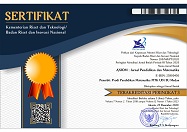ANALISIS KEMAMPUAN PEMAHAMAN KONSEP SISWA PADA MATERI PROGRAM LINIER
Abstract
Penelitian kualitatif ini bertujuan mendeskripsikan bagaimana kemampuan pemahaman konsep matematis siswa pada materi program linear. Pemilihan subjek penelitian ini menggunakan metode purposive sampling, dengan populasi penelitian berjumlah 60 orang siswa kelas XI MAN 1 Aceh Tengah. Teknik pengumpulan data menggunakan tes kemampuan awal, tes kemampuan pemahaman konsep, dan lembar wawancara. Hasil data dipaparkan dan dianalisis secara kualitatif. Berdasarkan analisis yang telah dilakukan, diperoleh kesimpulan bahwa hasil analisis terhadap kemampuan pemahaman konsep matematis yaitu: (1) siswa berkemampuan tinggi dapat memenuhi 4 dari 5 indikator sehingga berada pada persentase 87% dengan kategori sangat baik, (2) subjek dengan kemampuan pemahaman konsep matematis sedang memenuhi ke 5 indikator pemahaman konsep berada pada persentase 87% dengan kategori sangat baik, dan (3) subjek berkemampuan rendah hanya memenuhi 2 indikator dari 5 indikator pemahaman konsep berada pada persentase 53% dengan kategori cukup. Hasil analisis tes kemampuan pemahaman konsep matematika menunjukkan bahwa siswa dengan kemampuan matematika tinggi memenuhi lima indikator, yaitu: (1) pengulangan konsep, (2) penyajian contoh dan non contoh, (3) mengklasifikasikan objek, (4) penyajian konsep dalam berbagai bentuk representasi matematis, dan (5) penerapan konsep dalam pemecahan masalah.
Abstract
This qualitative research aims to describe students’ ability to comprehend mathematical concepts in linear programming material. The research subjects were selected using a purposive sampling method, with a research population of 60 students from class XI MAN 1 Central Aceh. Data collection techniques included initial ability tests, concept understanding ability tests, and interview sheets. The data results were presented and analyzed qualitatively. Based on the analysis that has been carried out, it is concluded that the ability to comprehend mathematical concepts is as follows: (1) students with high abilities can fulfill 4 of the 5 indicators, placing them at a percentage of 87% in the very good category, (2) subjects with moderate ability to comprehend mathematical concepts fulfill all 5 indicators of conceptual understanding, placing them at a percentage of 87% in the very good category, and (3) low ability subjects only fulfill 2 indicators of the 5 indicators of conceptual understanding, placing them at a percentage of 53% in the sufficient category. The results of the analysis of tests on the ability to comprehend mathematical concepts show that students with high mathematical abilities meet five indicators, namely: (1) repetition of concepts, (2) presentation of examples and non-examples, (3) classification of objects, (4) presentation of concepts in various forms of mathematical representation, and (5) application of concepts in problem solving.
Keywords
Full Text:
PDF (Indonesian)References
Aida, N., Kusaeri, K., & Hamdani, S. (2017). Karakteristik instrumen penilaian hasil belajar matematika ranah kognitif yang dikembangkan mengacu pada model pisa. Suska Journal of Mathematics Education, 3(2), 130. https://doi.org/10.24014/sjme.v3i2.3897
Duffin, J., & Simpson, A. (2006). Understanding their thinking: the tension between the cognitive and the affective. Perspectives on Adults Learning Mathematics, 1990, 83–99. https://doi.org/10.1007/0-306-47221-x_5
Fajar, A. P., Kodirun, K., Suhar, S., & Arapu, L. (2019). Analisis kemampuan pemahaman konsep matematis siswa kelas viii smp negeri 17 kendari. Jurnal Pendidikan Matematika, 9(2), 229. https://doi.org/10.36709/jpm.v9i2.5872
Febriantika, A. A. (2020). Kemampuan pemahaman konsep matematis ditinjau dari kompetensi keahlian. AlphaMath : Journal of Mathematics Education, 5(2), 1. https://doi.org/10.30595/alphamath.v5i2.7329
Febryana, D. (2017). Profil kreativitas siswa dalam menyelesaikan soal segitiga dan segiempat ditinjau dari gender. Suska Journal of Mathematics Education, 3(2), 130. https://doi.org/10.24014/sjme.v3i2.3897
Hendriana, H., & Soemarmo, U. (2014). Penilaian pembelajaran matematika. Refika Aditama.
Hoiriyah, D. (2020). Analisis kemampuan pemahaman konsep matematis mahasiswa program studi pgsd. Logaritma : Jurnal Ilmu-Ilmu Pendidikan Dan Sains, 8(02), 199–212. https://doi.org/10.24952/logaritma.v8i02.2773
Hutagalung, R. (2017). Peningkatan kemampuan pemahaman konsep matematis siswa melalui pembelajaran guided discovery berbasis budaya toba di smp negeri 1tukka. Journal of Mathematics Education and Science), ISSN(2), 70. https://doi.org/10.30743/mes.v2i2.133
Khairani, B. P., Roza, Y., & Maimunah. (2021). Analisis kemampuan pemahaman konsep matematis siswa kelas xi sma/ma pada materi barisan dan deret. Jurnal Cendekia: Jurnal Pendidikan Matematika, 05(02), 1578–1587. https://doi.org/10.31004/cendekia.v5i2.623
Khairunnisa, N. C., & Aini, I. N. (2019). Analisis kemampuan pemahaman konsep matematis dalam menyelesaikan soal materi spldv pada siswa smp. Prosiding Seminar Nasional Matematika Dan Pendidikan Matematika Sesiomadika 2019, 1(1), 546–554. https://journal.unsika.ac.id/index.php/sesiomadika/article/view/2814/1893
Khasanah, M., Utami, R. E., & Rasiman. (2020). Analisis kemampuan pemahaman konsep matematis siswa sma berdasarkan gender. Imajiner: Jurnal Matematika Dan Pendidikan Matematika, 2(5), 347–354. https://doi.org/10.26877/imajiner.v2i5.6517
Munawaroh, N., Rohaeti, E. E., & Aripin, U. (2018). Analisis kesalahan siswa berdasarkan kategori kesalahan menurut watson dalam menyelesaikan soal komunikasi matematis siswa smp. JPMI (Jurnal Pembelajaran Matematika Inovatif), 1(5), 993. https://doi.org/10.22460/jpmi.v1i5.p993-1004
Novitasari, D., Triutami, T. W., Wulandari, N. P., Rahman, A., & Alimuddin, A. (2020). Students’ creative thinking in solving mathematical problems using various representations. Proceedings of the 1st Annual Conference on Education and Social Sciences, 465(Access 2019), 99–102. https://doi.org/10.2991/assehr.k.200827.026
Rismawati, M., & Hutagol, A. S. R. (2018). Analisis kemampuan pemahaman konsep matematika mahasiswa pgsd stkip persada khatulistiwa sintang. Photosynthetica, 2(1), 1–13. https://doi.org/10.31932/jpdp.v4i1.17
Sari, A., & Yuniati, S. (2018). Penerapan pendekatan realistic mathematics education (rme) terhadap kemampuan pemahaman konsep matematis. Jurnal Cendekia : Jurnal Pendidikan Matematika, 2(2), 71–80. https://doi.org/10.31004/cendekia.v2i2.49
Septian, A., & Ramadhanty, C. L. (2020). Peningkatan pemahaman konsep matematika siswa smp melalui model pembelajaran kooperatif tipe jigsaw. WACANA AKADEMIKA: Majalah Ilmiah Kependidikan, 4(1), 56. https://doi.org/10.30738/wa.v4i1.7782
Siki, D., Djong, K. D., & Jagom, Y. O. (2021). Profil pemahaman konsep matematika siswa smp dalam menyelesaikan masalah matematika. Leibniz: Jurnal Matematika, 1(1), 36–43. https://doi.org/10.59632/leibniz.v1i1.55
Wardani, S. (2009). Meningkatkan kemampuan berfikir kreatif dan disposisi matematik siswa sma melalui pembelajaran dengan pendekatan model sylver. [Disertasi, Universitas Pendidikan Indonesia].
DOI: http://dx.doi.org/10.30821/axiom.v12i2.18077
Refbacks
- There are currently no refbacks.
Copyright (c) 2024 Nur Ainun Lubis, Elfi Rahmadhani

This work is licensed under a Creative Commons Attribution-ShareAlike 4.0 International License.
p-ISSN: 2087-8249 | e-ISSN: 2580-0450
Indexed by:
AXIOM : Jurnal Pendidikan dan Matematika is licensed under a Creative Commons Attribution-ShareAlike 4.0 International License.











